#central city citizen
Explore tagged Tumblr posts
Text

Today is the only day you can post this
#the flash#newspaper#2024 april 25#flash missing vanishes in crisis#central city citizen#cw flash#red skies vanish
8 notes
·
View notes
Text

#the flash#flash missing#crisis on infinite earths#flash#central city#central city citizen#cw flash#the flash tv#the flash tv series#april 25#dc comics#cw dc#dc the flash
0 notes
Text
Nikolaj Coster-Waldau on stage at the Global Citizen Festival 2024 🌍
📌 Central Park, New York City
📆 September 28, 2024
(-> twitter thread)










#nikolaj coster waldau#nikolaj coster-waldau#nikolajcw#ncw#twitter thread#global citizen festival#Global Citizen#central park#new your city#new york#climate change#undp#undp goodwill ambassador
15 notes
·
View notes
Text
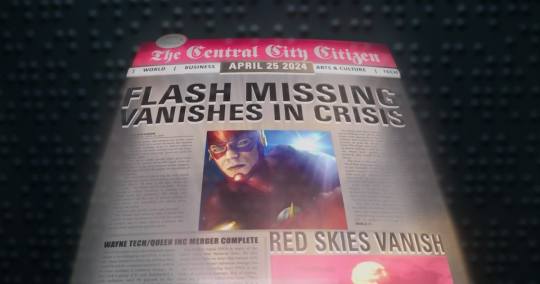
That's today
16 notes
·
View notes
Text
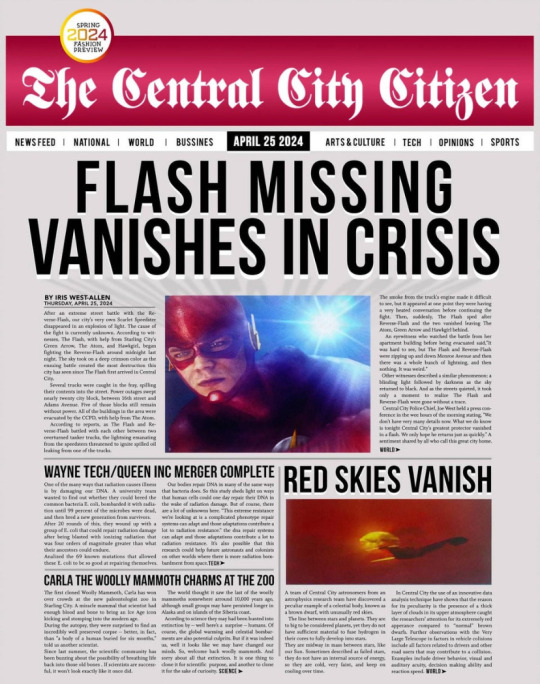
It’s time
#the flash#the cw flash#cw flash#the flash cw#crisis on infinite earths#central city#the central city citizen#iris west allen#barry allen#Wayne tech#queen inc#Carla the wooly mammoth#reverse flash#cwverse#arrowverse#dc#dc flash
11 notes
·
View notes
Text
Bruhhh, not our boy Jungkook barking right tf back at us during the Global Citizen Festival. Istg we don't deserve him; he matches our energy so welll.
#Global Citizen Festival#jungkook#jeon jungkook#new york#new york city#central park#army#bts#bts jungkook#woof woof#bark bark
1 note
·
View note
Text
Delivery!
Flash was currently being held captive in a black of ice. How he got like this he wasn't sure. All he remembered was that he was running across Central City keeping the peace until suddenly an ice beam shot out of nowhere and froze his feat to the ground.... and the rest of him.
"Alright you got me! Show your face!"
"Well I was going to regardless. No need to yell." Out pops Danny Phantom carrying a bag with him and holding out an envelope.
"What? Who are you?"
"My name's Phantom. Danny Phantom. I have a message for you. I couldn't get your attention earlier so I thought this was just the next best way to get you to stop." Danny said as he unfreezes the speedster.
"Uh, okay." Flash said as Danny gives him an envelope.
On the envelope there are drawing in crayon and stickers and in marker it says: to Flash.
"It's from Susie, she'd said you'd remember her."
He remembered a Susie, a little girl that he used to see in the children's hospital. She had leukemia. He spent any minute he could making sure the kid was smiling when he was there. He was heartbroken when the nurses told him that she had passed away before he could give her her birthday present. Flash examined the crayon written words, it was just like Susie's writing.
"How did you?"
"Just read it."
The letter reads:
Dear Flash,
I'm sorry, I wasn't there when you showed up for my birthday. I never got to tell you, but thank you for being at the hospital with me when I was scared of going to treatment or when I had to take my medicine. Thank you for making me smile even when I didn't feel well. Thank you for playing games with me when I couldn't go outside. Thank you for talking to my mom and dad at my funeral. That was really nice. I drew some pictures for you but I never got to finish them when I was in the hospital so I drew you some new ones. Danny says that he'll give them to you.
In the envelope was a series of different colored papers all with different crayon and marker drawings of Susie and him playing in different scenarios. One where she was a doctor and he played the injured patient. One where they were both superheroes. Another one where they were playing shadow puppets when she wasn't feeling well. Page after page were different drawings of them playing with the last one was covered in glitter with a big heart with a crayon drawing of him and Susie.
"Susie said that her biggest regret was that she couldn't say thank you to her hero before she passed. So I bumped her up on my delivery list."
"What?"
"Oh yeah, I never fully introduced myself. I'm Danny Phantom, you can call me Danny. I'm the designated delivery person for the afterlife to the living realm. Any messages or special requests from the dead are delivered by me!" Danny hands him a business card all official.
And it does say: Danny Phantom special delivery service for those of the non-living variety!
"She also said she wanted to give you one last hug before moving on."
"What do you?" Flash is halted from saying anything else as he feels a pressure against his legs. He looks down to see a translucent small figure. She was a picture of what she looked like before the chemo. Susie gives him a smile and a hug before fading before his eyes.
Before Danny officially takes up the mantle of Ghost King he's trying to do a job that would have him interact with all of his citizens first so he could get a feel of it. Hence him making connections with both the living and non-living people (he went big-brain for this idea)
Extra scene:
"Oh that reminds me, I have a card for you from someone else."
"A card?" Flash opens the card only to get sucker-punched in the face. (like one of those cartoon boxing glove punches)
"A punch card." Danny said
Flash groans as he looks at the card that has the words: STOP MESSING WITH TIME! from CW
Obligatory Gotham Scene:
Danny standing in front of a beaten up Joker that has been tied to a chair.
"Just so you know I have a back order of a lot special requests for you. And since I can't exactly kill you, that would create so much political tape. I can let them make requests for certain actions. So right now I have over 50 requests for me to break your legs and over 30 to pull out your teeth and break your jaw. Some of them contradict each other because they want to make every word you say hurt you but others want me to curse you so you can't speak again. So I'll just have to get creative." Danny says winding his arm back and form.
He is for sure being completely professional about, he gets no personal gratification from beating up a crazy clown at all. (said nobody ever)
#dp x dc#dp x dc au#dp x dc crossover#danny phantom x dc#the flash#barry allen#dpxflash#dp x dc prompt#Can you imagine a scenario of Danny just walking into the Wayne manor and just holding out a care package for the whole batfamily#This is from your Grandma and Grandpa#And gives Alfred his own separate care package along with a message of thanks for how much the butler does for the family#Danny's just like “this is for the crime fighting family with the furry theme going on”
3K notes
·
View notes
Text
"As solar panels heat up beyond 25°C, their efficiency decreases markedly. Green roofs moderate rooftop temperatures. So we wanted to find out: could green roofs help with the problem of heat reducing the output of solar panels?
Our research compared a “biosolar” green roof — one that combines a solar system with a green roof — and a comparable conventional roof with an equivalent solar system. We measured the impacts on biodiversity and solar output, as well as how the plants coped with having panels installed above them.
The green roof supported much more biodiversity, as one might expect. By reducing average maximum temperatures by about 8°C, it increased solar generation by as much as 107% during peak periods. And while some plant species outperformed others, the vegetation flourished.
These results show we don’t have to choose between a green roof or a solar roof: we can combine the two and reap double the rewards...
How did the panels affect the plants?
In the open areas, we observed minimal changes in the vegetation cover over the study period compared to the initial planted community.
Plant growth was fastest and healthiest in the areas immediately around the solar panels. Several species doubled in coverage. We selected fast-growing vegetation for this section to achieve full coverage of the green roof beds as soon as possible.
The vegetation changed the most in the areas directly below and surrounding the solar panels. The Baby Sun Rose, Aptenia cordifolia, emerged as the dominant plant. It occupied most of the space beneath and surrounding the solar panels, despite having been planted in relatively low densities.
This was surprising: it was not expected the plants would prefer the shaded areas under the panels to the open areas. This shows that shading by solar panels will not prevent the growth of full and healthy roof gardens.
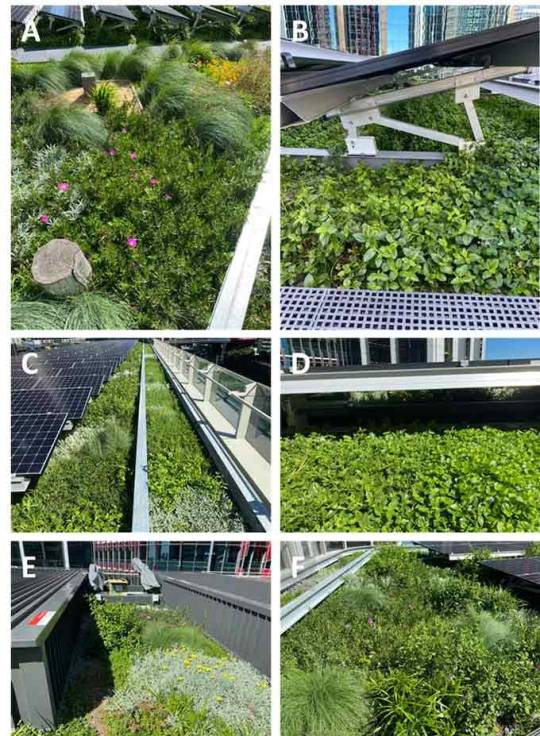
What were the biodiversity impacts?
We used environmental DNA (eDNA) surveys to compare biodiversity on the green roof and conventional roof. Water run-off samples were collected from both roofs and processed on site using portable citizen scientist eDNA sampling equipment to detect traces of DNA shed by the species on the roof.
The eDNA surveys detected a diverse range of species. These included some species (such as algae and fungi) that are not easily detected using other survey methods. The results confirmed the presence of bird species recorded by the cameras but also showed other visiting bird species went undetected by the cameras.
Overall, the green roof supported four times as many species of birds, over seven times as many arthropods such as insects, spiders and millipedes, and twice as many snail and slug species as the conventional roof. There was many times the diversity of microorganisms such as algae and fungi.
Encouragingly, the green roof attracted species unexpected in the city. They included blue-banded bees (Amegilla cingulata) and metallic shield bugs (Scutiphora pedicellata).
How did the green roof alter temperatures?
The green roof reduced surface temperatures by up to 9.63°C for the solar panels and 6.93°C for the roof surfaces. An 8°C reduction in average peak temperature on the green roof would result in substantial heating and cooling energy savings inside the building.
This lowering of temperatures increased the maximum output of the solar panels by 21-107%, depending on the month. Performance modelling indicates an extensive green roof in central Sydney can, on average, produce 4.5% more electricity at any given light level.
These results show we don’t have to choose between a green roof or a solar roof. We can combine them to take advantage of the many benefits of biosolar green roofs.
Biosolar roofs can help get cities to net zero
The next step is to design green roofs and their plantings specifically to enhance biodiversity. Green roofs and other green infrastructure may alter urban wildlife’s activities and could eventually attract non-urban species.
Our green roof also decreased stormwater runoff, removed a range of run-off pollutants and insulated the building from extremes of temperature. A relatively inexpensive system provides all of these services with moderate maintenance and, best of all, zero energy inputs.
Clearly, biosolar green roofs could make major contributions to net-zero cities. And all that’s needed is space that currently has no other use."
-via GoodGoodGood, May 12, 2024
#green#green roof#biosolar#solar power#solar panels#rooftop solar#solarpunk#native plants#australia#sydney australia#biodiversity#conservation#climate change#climate action#climate hope#global warming#temperature#climate adaptation#cooling#good news#hope
2K notes
·
View notes
Note
🌶️
The MCU's Spiderman is not a poor execution of Peter Parker's character concept. He's not even poor execution of Miles Morales's character concept.
He is a poor execution of Terry McGinnis's character concept.
Peter Parker and Miles Morales both have so many fundamental pieces to their characters that are just missing for the MCU's Spiderman. Familiar names are floating around him- Aunt May, Mary Jane, Ganke Lee- but the fundamental ideas that make up Peter or Miles arcs just are not there. Themes like Miles's family expectations, Peter's constant money struggles, and the balancing act of doing good vs trying to live your own life are all absent. Even the idea of power and responsibility isn't properly introduced until the THIRD MOVIE when that really should been the central theme from the beginning.
Rather the MCU Spiderman has way more parallels with Terry McGinnis. Both are young hot shot teenagers who end up being taken under the wing of established and experienced hero who is on their way out. Both have complex relationships with their mentor which in a lot of ways serves as the driving force of their character arcs. Both gain high tech suits which enable their heroism. Both are viewed (or at least supposed to be viewed in MCU Peter's case) as heirs to the legacy of this hero.
It falls apart when you get into how they are different. While Uncle Ben is implied to have existed and be dead by the time MCU Peter is introduced in Civil War it's never actually confirmed and never properly comes up. Meanwhile the death of Terry's father is essentially the inciting incident of Batman Beyond: it's what motivates and drives Terry and the murder and it's fallout are the main focus of the first two episodes of Batman Beyond.
What's more MCU Peter's relationship to Tony is grounded in the fact that Tony just shows up one day and essentially taps him to join the Avengers. Bruce by contrast initially tosses Terry out on his ear, and when Terry turns up seeking justice for his father Bruce can't offer him anything but 'go ask the cops for help', and when that goes exactly as poorly as Terry said it would, Terry breaks into the manor steals the Batsuit and goes to stop Powers himself. Terry has active agency in his own choice to be a hero, which helps define his relationship with Bruce and to heroism. While MCU Peter was doing his own superheroics prior to Tony showing up in Civil War (not that he ever does much of that in future movies) his relationship to Tony is defined by Peter's dependence on him and his quest for Tony(/the Avengers)'s approval. And because they don't even bother name drop Uncle Ben or flashback to him, we're left with the impression that the main thing driving MCU Peter is that quest for approval. His motivations are never more complexly explored, and we don't even really see him just running around Queens stopping muggings or car crashes or anything that hints he enjoys or feels the need to actually help people.
And I think that gets into the final and most important difference between the two. Gotham not only needs Batman, it visibly and obviously and terribly needs Batman. Batman Beyond leans into this because decades without a Batman have left Gotham a cyperbunk dystopian hellscape. The city needs someone to stand up to the darkness, to be a symbol of hope, to be aspirational. Terry taking up that mantel means fighting supervillains, yes- but mostly it means doing what the original Batman did. Solving murders, stopping muggings, rescuing people from burning buildings or fighting off street gangs like the Jokerz.
But even in the earliest MCU movies, New York only needs superheroes when the current world ending threat shows up. Otherwise the city is all bright shinny clean streets filled with haplessly content citizens. This is the only reason that Vision's position of 'Our very strength invites challenge' in Civil War makes any sense- because the only purpose of these Superheroes is usually to fight a threat they where somehow responsible for creating. And this problem hits 'friendly neighborhood Spiderman' the hardest because he only has a responsibility to use his great power to solve problems, if their are problems in need of solving. Most of Peter Parker's (and Miles Morales's, Gwen Stacy's, or any other Spiderperson's) day is not fighting alien armies or netherworld gods. It's stopping break ins, rescuing people from car crashes, or dealing with other small scale local threats, that none the less benefit from someone with his abilities to make them better. Either New York in the MCU is an ideal utopian city where the police have everything handled apparently (which ha!) or Peter is apparently not interested in stopping bad things from happening. He spends so much of the first movie basically begging Tony to give him superhero things to do, not realizing that he could go outside and find people that need help on his own.
In conclusion MCU Peter Parker isn't 'regular Peter Parker but not an underdog', or even 'Miles Morales but white'. He's 'Terry McGinnis but without any agency in his own heroism'.
#The Spicy Take Zone#Batman Beyond#Spiderman#Peter Parker#Miles Morales#terry mcginnis#MCU#anyways the only Batman Beyond adaption I want is one done by the Into the Spiderverse crew#I can't see a DC live action movie not butchering him badly#the only truly good live action Batman of my lifetime was the Robert Pattinson one#since it genuinely seemed to get the character in a way most others did not
546 notes
·
View notes
Text
archduke! leona kingscholar

archduke!leona kingscholar, who is granted the title and a duchy comprising of the outlands of the sunset savannah to rule, who at first rejects the title thinking it a trap. after weeks of falena and the queen convincing him it is not, leona is formally crowned the archduke of the sunset savannah, a king in his own right. the only catch? leona must present records of finance and laws passed once every six months.
archduke!leona kingscholar, who modernises and uplifts the "boonies", as ruggie calls the place, with the help of former savanaclaw students whom he hires and pays fair wages to, allowing the younger ones to freely pursue internships under him and their other seniors and even setting up schools and colleges allied to a central university in sunrise city.
archduke!leona kingscholar, who isn't even considered a ruler by the people he rules over, instead considered a friend, a son, a grandson, a brother, an uncle. in the evenings when the sun hangs low in the sky and you can see the bare outline of the moon, leona can be found playing spelldrive with the kids while some neighbourhood preteens fight over his guitar, their mothers and grandmothers apologising for damage done while he chuckles.
archduke!leona kingscholar, who welcomes his son and heir in a place filled with love and praise for his efforts, the citizens of his duchy always open to lending him a hand when the going gets tough. "you helped raised our boys, even though you didn't have to," the mothers start as they hug their future king gently, the child pawing at their breasts hungrily, mewling as his father chuckles, slightly embarrassed. "now it's our turn to help you."

this is one of my fave aus i've ever written for leona, second only to my more angsty immortal-bounty-hunter-leona au. bringing this back bc RUGGIE'S DREAM???? HELLO???? I WROTE THIS IN 2023 btw || 288 words, a repost from my now-deleted account @.ameleii :) || part 2 @puowei, @aivy-saur, @glidiaxoxo, @fungifanart, @nemisisnemi @loser-jpg, @bunnwich
#twst#twisted wonderland#twisted wonderland x reader#twst x reader#leona kingscholar#twst leona#leona kingscholar x reader#leona x reader#leona x yuu#leona twst
406 notes
·
View notes
Text
Stuff that actually happens in Bionicle:
Sexy snakes invent capitalism and then face severe regulation by a bunch of demonic mad scientists.
One of said mad scientists impersonated the mayor of a Frutiger Aero dystopia and put all of the citizens into The Pokéballs That Make You Smaller.
There are six fish-themed warlords with (for the most part) really on-the-nose names. They weren't always fish-themed, they just happened to be in a prison that became flooded with The Water That Makes You A Fish. Their main underling is a four-armed squid-man, who is naturally immune to The Water That Makes You A Fish.
The setting's equivalent of Hephaestus made a bunch of useful stuff, including but not limited: to the first six protagonists, the leader of the Bionicle CIA, some cool planes, and the Bionicle CIA's prison-warden robots.
One of the Magic Frisbees that are the central macguffins of the 2004 arc was stuck between the teeth of the Bionicle equivalent of The Bloop.
Some shark guys who were the antagonists of the 2006 arc got put into the Water That Makes You A Fish. They got turned into eels.
There's an entire group of heroes who were brought together to protect the mad scientist I mentioned earlier, then got turned into tiny lizard creatures by one of the sexy snakes, and they didn't get turned back until thousands of years later.
A random villager from an underwater city (which is directly next to the prison that got flooded with the Water That Makes You A Fish) was transformed by the main macguffin into said prison's jailer, who by that point had already been dead for several millenia after being shanked by the blue fish-themed warlord.
There's a substance called Black Fire, which isn't literally black fire. The CIA's warden robots are filled with (and presumably powered by) it, and can shoot it out of their giant impractical swords.
The Makuta devolution scene.
Bionicle Frankenstein's name can also refer to his private island and also a giant plant monster.
484 notes
·
View notes
Text
🚨 The catastrophic situation in northern Gaza continues as the siege persists for the seventh consecutive day. Hospitals are shut down, bombardment targets every location, homes are demolished, and dozens are wounded because they dared to move under drones. Entry of food, water, and fuel has been completely blocked.
The Red Crescent has declared that all ambulances in the northern Strip have run out of fuel.
Citizens have evidently been subjected to field executions in the north (Media 1). Civil Defense and medical crews have not stopped transporting martyrs. All Gazans are living under bullets under bombardment; every day, dozens are wounded by drones and bullets for trying to leave Jabalia camp.
Meanwhile, the situation at Kamal Adwan Hospital (https://t.me/PalestineResist/62084) in the north remains catastrophic, where patients have been evacuated due to overcrowding in the departments and lack of fuel.
Dozens of injuries were reported as the IOF indiscriminately dropped bombed on the tents of the displaced at the Faluja School in the northern #Gaza Strip moments ago. (Media 7) Dozens were wounded by drone bullets at the Al-Fawqa School, which houses displaced people in Jabalia; 15 wounded have been transported so far. A child that was just born was wounded by IOF targeting of homes (Media 2).
The attacks since dawn are distributed as follows: Jabalia:
Field executions and continuous bombardment.
Injuries in a bombing of a home in Jabalia, northern #Gaza Strip.
A martyr at the Namnam roundabout.
11 wounded, trapped in their home in Bir Al-Naja following IOF targeting.
18 wounded among displaced after a drone opened fire on a shelter for the displaced near Birkat Abu Rashid in Jabalia.
Dozens wounded by drone fire at the Al-Fawqa School.
Dozens of injuries as the IOF indiscriminately dropped bombed on the tents of the displaced at the Faluja School.
4 martyrs and 8 wounded as a result of the shelling of the Al-Azizi and Azzam families in the Faluja area.
Two martyrs from the Jarjawi family after the IOF bombed the Saftawi area.
Several wounded under the rubble of the Abu Rakba family home in Tal Al-Zaatar area in the northern Strip (Media 5).
A female martyr and several wounded as a result of the IOF bombing the Hasfa School in Jabalia Camp.
Gaza City:
Wounded after IOF drones targeted a group of 15 citizens in Zaytoun, south of Gaza City.
Martyrs and wounded in the IOF's bombing of the Al-Dayah family home southwest of Gaza City.
6 martyrs as a result of the IOF bombing a home in Al-Mughrabi Street southwest of Gaza City in the northern #Gaza Strip.
3 martyrs as a result of the IOF bombing a home in Sabra neighborhood, south of Gaza City.
Nusseirat, Deir Al-Balah, and Maghazi:
Injuries in a bombing of a home west of Nusseirat camp, central #Gaza Strip.
Two martyrs and several injured among displaced in the bombing of a home of the Kurd family in Deir Al-Balah.
Martyrs and wounded in a drone strike on citizens in Maghazi camp in the central #Gaza Strip.
A child martyr and several wounded in the bombing of the Bayoumi family apartment in Nusseirat camp, central #Gaza Strip. (Media 3)
A martyr and several critically wounded as a result of the IOF bombing a home in Nusseirat camp, central #Gaza Strip.
#palestine#free palestine#gaza#free gaza#current events#jerusalem#yemen#tel aviv#israel#palestine news#nusseirat#deir al balah#maghazi#gaza strip#gaza city#iof war crimes#fuck the iof#al mughrabi#jabalia#namnam#red crescent#hospital#kamal adwan hospital#al fawqa
595 notes
·
View notes
Text
[ 📹 Israeli occupation airstrikes targeted Khan Yunis, in the south of Gaza, leaving several casualties among paramedics and civil defense teams. The Palestinian Red Crescent says occupation forces continue to target ambulance and civil defense crews in the latest of Israel's crimes.]
🇮🇱⚔️🇵🇸 🚨 💥PARAMEDICS AND JOURNALISTS TARGETED ON 97TH DAY OF ISRAELI GENOCIDE💥
Israeli Occupation Forces ramped up their bombing and shelling of the Gaza Strip Thursday, killing dozens and targeting journalists and paramedics on the 97th day of the Israeli genocide of Palestinians.
In the south of the Gaza Strip, six Palestinian civilians were killed and many more wounded east of Khan Yunis, as a result of bombing raids by Israeli jets.
Also in the South of Gaza, occupation aircraft bombarded the home of the Bassam Abu Namous family on al-Samasma Street, west of Khan Yunis, killing seven civilians and wounding 25 others.
Occupation helicopters also fired sporadically into Khan Yunis, killing 19 over the previous day, due to Israeli bombardment.
IOF soldiers also continue to bomb and shell various residential homes in the Qaizan al-Najjar neighborhood in the south of Khan Yunis.
In Gaza City, IOF warplanes targeted the home of journalist Mohammed al-Thalathiini, killing the reporter and bringing the death toll among journalists in Israel's genocide to 112 since October 7th.
Israeli forces also targeted the al-Bureij, al-Maghazi, al-Nuseirat and the al-Mughraqa Camps area in central Gaza with heavy artillery fire and bombing raids.
In addition to these crimes, a Palestinian youth was seriously wounded as a result of targeting by an Israeli missile fired from a drone on al-Bahr Street in Rafah, southern Gaza.
Meanwhile, elsewhere in the north of Rafah, southern Gaza Strip, the Abu Hatab family home was targeted by the Israeli occupation, killing six and wounding several others.
A multitude of wounded Palestinian civilians were also rushed to al-Shifa Medical Complex in the west of Gaza City, with three citizens killed from the Machi family, in the vicinity of the now defunct and destroyed Gaza International Airport that once existed in the enclave's capital.
In central Gaza, six Palestinians, including four from ambulance crews, were slaughtered when occupation jets targeted and bombed an ambulance on Salah al-Din Street, adjacent to the al-Maghazi Refugee Camp.
According to the Palestinian Red Crescent Society (PRCS), the Israeli occupation "deliberately targets" its ambulance crews, even when coordinating with International partners, with the PRCS warning against the targeting of the few remaining medical centers in the area.
A Palestinian residential home was also targeted near the entrance to al-Aqsa Martyrs Hospital in the Deir al-Balah area, resulting in the deaths of 12 civilians including journalist Ahmed Badir.
While in central Gaza, in the al-Maghazi Refugee Camp area, at least 17 civilians were murdered in strikes by occupation munitions, while Israeli forces also heavily bombed and shelled the al-Bureij and Nuseirat Camp residential areas.
In addition, Wafaa al-Bass, a recently freed prisoner held by the occupation, was killed in her home in the north of the Gaza Strip.
Since the beginning of Israel's genocide of Palestinians in the Gaza Strip began on October 7th, 2023, in excess of 23'357 Palestinians have been killed, with an additional 59'410 wounded in Israeli war crimes.
#source1
#source2
#videosource1
@WorkerSolidarityNews
#gaza#gaza strip#gaza news#gaza war#gaza genocide#war in gaza#genocide in gaza#genocide of palestinians#israeli genocide#israeli war crimes#israeli crimes#israeli occupation#israeli occupation forces#israel#israel news#palestine#palestine news#war crimes#crimes against humanity#middle east#politics#news#geopolitics#world news#global news#international news#war#breaking news#current events#israel palestine conflict
2K notes
·
View notes
Text
We're in the early hype cycle for Civ 7, which is all well and good- Civ is Civ, it's gonna be amazing and completely destroy large chunks of global productivity for a while. They're doing an unusually good job of targeting me in particular this time- the "build something you believe in" ad copy is one of those sentiments that has root access to my brain.
But anyway, sifting through the pre-release details has me thinking again about the... I guess you'd call it a 4x game still, but the game that part of me always wishes Civ was. I think a lot of people probably have a sort of personal 'Civ Prime' in their heads, actually, the secret changes they'd make if it was 'their' game. My own Civ Prime goes like this:
Actually-existing Civ always takes the stance that cultures create persons; you build a settler, send it off to some promising river valley, and plonk down a town. The glorious leader then directs the citizens to harvest and cultivate the fertile land around them, and surpluses of food allow the population to grow.
As a corollary, the map in actually-existing Civ starts out nearly empty; aside from a few barbarian camps and city states (or in Civ 7, the 'independent settlements'), the area outside your borders is in a pristine state of nature. And that's all well and good for game purposes, but in "my" Civ I'd reverse this entirely: civilization, not as some supra-human entity that creates and defines humans, but as a narrative that structures their identities and guides their values.
Consider a hex map of the usual sort, but the yields per tile are the local surplus, that is, the amount that tax collectors can extract from the people indigenous to that location without killing them. You begin play at the dawn of agriculture, as a leader/stationary bandit with enough military support and personal legitimacy to enforce those taxes, funnel the surplus towards a centralized urban center, and direct it towards military, priest, or artisan classes. Every hex is a conquest in miniature; at least at first, the size of your territory is directly downstream of your military strength.
That strength is tracked as "Might" or some such civ-wide stat, initially a strict function of how much wealth (that is, grain) that you feed in to it. This represents loosely organized, loyal bravi who are in your employ; they go to hexes you designate, dominate the locals, and render a tile 'productive'. In times of crisis, you can- very temporarily- initiate a levy to make these become traditional army units (and indeed this is the only source of such units, at first). As long as these exist, they are tremendously destructive to any hex they're on, friendly or otherwise, acting as a natural disaster that damages future tile yields for several turns; if every tile around them is already so damaged, they disband automatically. And of course these 'crystalized' forms of Might reduce the 'liquid' Might you have to control tiles, so lengthy wars will also see borders destabilize because you can no longer enforce order in the outer hexes.
But of course military strength isn't the only priority; grain (and later, currency, etc.) sent to the Artisan class allows you to slowly build permanent structures, which have their own bonuses as you'd expect. It's a time-horizon question; investment in Might is a larger immediate bonus, including higher revenues, but wealth spent on infrastructure accumulates.
This is also how you seed new urban areas: Artisans can build things like fortresses, temples, etc. (depending on the initial bonuses that you want) on rural hexes that are distant from existing cities, with tribute from hexes always flowing to the nearest such seed. That wealth in turn supports the new military, industrial, and cultural classes centered on that hex. This can also happen automatically in neutral territories; wherever there are large volumes of unclaimed surplus, NPC urban centers are liable to form at random and begin acting as your opponents.
You can also invest in "Culture," which in the early days generally means a priest caste. And this is where I get a bit clever.
Culture is an umbrella for anything that counts as "an idea", everything from religious formation, to technology, to philosophical ideas and organizing ideologies. There's a base track, mostly 'pure idea' stuff like mysticism and foundational concepts like writing and lawmaking; throw in a few unique ones for your chosen Civ identity (Egyptians get something about handling river flooding, whatever). And every point invested in Might and Artisan classes also helps unlock new ideas to be researched here; once you open those up, they can be researched here with Culture points. All contain some kind of advantage; new types of army units to levvy, new structures to build, higher yields or new types of resources to extract from the map- the usual.
The trick with culture unlocks is, they're not bonuses for you only. Ideas appear in the urban hex where they're researched, but they spread to adjacent hexes at some fixed rate, hopping from tile to tile and stopped only by uninhabited regions like mountain ranges or extreme deserts that don't have a high enough population- and following trade networks from city to city especially quickly. For example, "irrigation" would be an idea that greatly increases grain surpluses in every hex near a river, both for your territory and for neutral or even enemy hexes as it spreads.
As compensation, whenever your ideas spread to a hex, you gain a slowly-decaying bonus on that space called authority, which means that you require less military force to extract its surplus, and it's easier for you to contest the tile against another sovereign. This attenuates with distance from the originating point, but if you're investing in Culture at a good clip, the hexes immediately around your urban centers will be very cheap or even free to extract wealth from. If you're really booking it, hexes will spontaneously submit to you without ever being formally dominated. This creates an "imperial core" dynamic as the game matures, with your military might being concentrated in the provinces, and allows you to extend your reach much further than you otherwise would, extract wealth accordingly, and push yourself in to a virtuous feedback loop / golden age where you snowball outwards with both territorial gains and rapid intellectual progress.
The double-secret trick here is that authority decays; spreading ideas to a tile can only secure its loyalty for so long before they become the 'new normal'. With proper tuning, every civ's "golden age" period would last for a while, but then when it inevitably reached natural barriers or other obstacles, this would reverse into a death spiral. Absent further expansion, authority would begin decaying faster than it was gained, first in the outer provinces; military expansion would give way to managing a cascade of discontent and rebellions, which would further weaken the imperial core- and so on, unto dissolution.
The triple-secret trick is this: rural hexes are just hexes, but when a fully fledged city rebels against the sovereign empire, the player can declare the rebel city to be the 'true inheritor' of their legacy, and jump ship. In other words, you can take either side in a civil war. This switch triggers the legacy empire to become a more passive computer-controlled entity, and gives the emergent civilization a slew of cheap new ideas to promote, rapidly building their own authority- which of course has particular bonuses against their former overlords. Humankind and Civ 7 both implement an "Ages" system to simulate the rise and fall of civilizations over time, but this has the virtue of being a more organic/emergent property. Instead of artificially converting every Roman city in to the HRE in one fell swoop, the HRE emerges from the rotting carcass of Rome at a single point and carves out its own sovereignty by the sword.
And now you face an interesting dilemma while you play: authoritarian social policies like suppressing foreign ideas can secure the longevity of your empire for centuries longer than it might otherwise last, but you know that sooner or later, the empire you're now controlling will be your immediate opponent during a new phase of expansion. Permissive social policies and liberal attitudes to trade and ideas will make that rebirth go further, faster, than it otherwise would. So do you defend the power you have now? Or do you make yourself vulnerable to your own future?
#late game would see major changes to this dynamic#e.g. nationalism allowing you to convert indigenous locals into 'citizens' that are more permanently loyal#professional militaries that can be paid from coffers instead of pillaging hexes#and so on
217 notes
·
View notes
Text
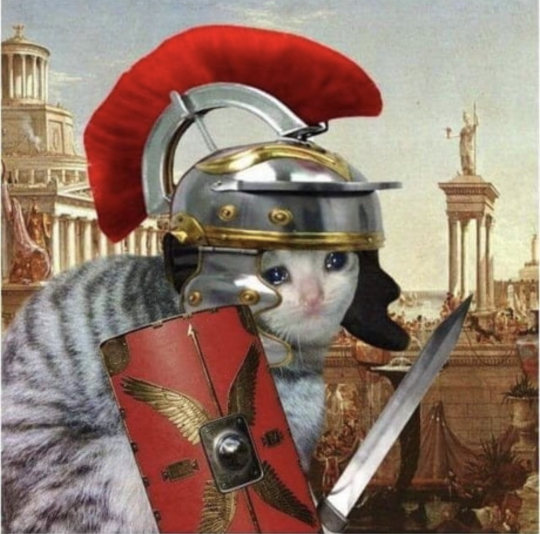
The Sad Fate of Roman War Veterans and How the Punic Wars Destroyed the Roman Middle Class
There's no question that Rome's victory over Carthage during the Punic Wars drastically changed the Roman Republic. Perhaps the most apparent change was Rome's ascendancy from a smaller power in Italy to the dominant power in the Mediterranean. In other words, a big fish in a small pond, to a big fish in a literal big pond. In the span of 120 years Roman territory expanded by vast amounts followed by further Roman expansionism resulting in Roman territory stretching from Spain and North Africa in the west to Greece and Anatolia in the east.


While the Punic Wars would transform Rome into an (e)mpire militarily, it also transformed Roman socio-economic structures. The early Roman Republic had no standing professional armies. Instead to wage war Rome used a militia system with citizen soldiers who were called up as needed. Since the state had no role in equipping soldiers, it was up to soldiers to equip themselves. Roman lower classes were exempt from military service since they could not afford weapons, armor, or supplies while the Roman upper class served as officers or elite cavalrymen. Thus, the responsibility for providing the rank and file infantry of the army fell to the Roman middle class. The Roman middle class consisted of some skilled artisans and small business owners, but by far most of the Roman middle class were farmers who owned small plots of land.
Up until the Punic Wars, this system worked fine as war was a small, short, local event that occurred within the confines of central and southern Italy. A Roman soldier didn't have far to travel from home as the enemy was within easy marching distance away. War was also a seasonal affair where the fighting occurred on the off season, then a truce was called so that soldiers could tend their farms during the growing season, with the war resuming once the crops were harvested. Now Roman soldiers were expected to be shipped to far off places such as Africa, Spain, Greece, Macedonia, and Anatolia. Whereas before wars were short seasonal affairs, now wars seemed to last forever with no recesses so that soldiers can tend their farms. Both the first and second Punic Wars nearly lasted two decades each. And war was everywhere as the Punic Wars involved multiple fronts all over the Mediterranean. No longer were Roman wars short, small, localized affairs. In the meantime while soldiers were away fighting, their fields were fallow and their businesses had fallen into disrepair. The Republic tried to mitigate the financial strains of the Punic Wars on its soldiers by paying a stipend. However it was not enough to prevent financial disaster. When the war ended and Rome's veterans returned home in triumph, they were broke and impoverished.
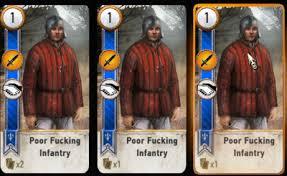
In order to make ends meet or pay off debt, most had to sell off their land to wealthy landholders, who consolidated that land into large estates and plantations. Many who sold their land became tenant farmers on the land that they had previously owned. Others moved to the city and tried to eek out a living as a laborer, however the price of labor was plummeting as Rome had taken tens of thousands of slaves during the Punic Wars and were taking tens of thousands more in various wars across the Mediterranean. War veterans found that there was no place for them in Roman society. Their farms and businesses were gone, and there was no need for their labor due to the sudden influx of slaves. Wealthy Roman elites had taken control of most of the Republic's land and wealth while a large percentage of the middle class were booted into poverty.
The result of everything I have previously described was a massive and ever growing rift between the rich and the poor as wealth became more and more concentrated at the top. This event became a hot button issue in Roman politics with Roman government being dominated between two unofficial political parties; the optimates, or those who supported the interests of the Roman elite, and the populares, or those who supported the interests of the common Roman. The clash between the optimates and populares led to increasing political instability resulting in the rise of demagogues and dictators. Civil war became common, and eventually the Roman Republic fell, giving rise to the Roman Empire.
youtube
309 notes
·
View notes
Text
Ok so remember this map?

A complete map of Jorvik, with a semi-accurate scale to measure any distance on the island. I’m really proud of it! There is, however, one glaring problem with this map.
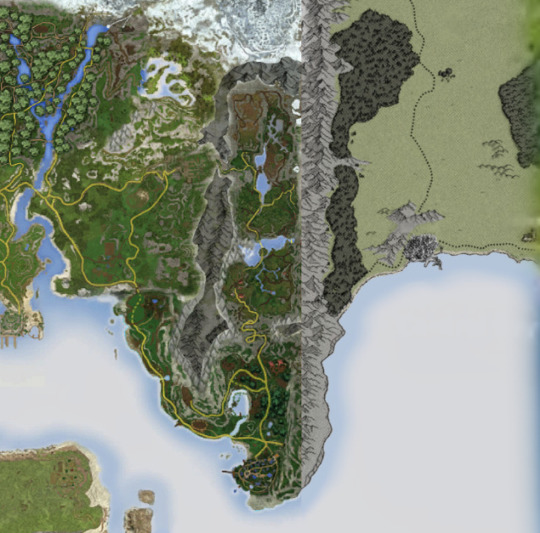
WHY IS JORVIK CITY SO SMALL????
I’m sorry but Jorviks capital should not be smaller than middle-of-nowhere ranger town Dundull. The generally accepted minimum population requirements for a city are 50 000 residents. Following the canon map, Jorvik city would need to fit at least 50 000 people in what looks like 2,25 square miles. That would mean Jorvik city houses 22 222 people per square mile, making it the 24th most densely populated city in the WORLD.
Possible? Sure. Likely? Considering the clear inspiration from the way less dense Stockholm, the lack of giant apartment complexes or slum neigbourhoods, which would imply that people live closely together, I’m gonna have to say no.
So how big should Jorvik city be, if the map size is inaccurate? Kind of hard to tell since we can’t see places like Governors Fall or Aideens Plaza on the map.
But there is one place we CAN see.


And if we can use this map, we can measure how long it takes to cross it.
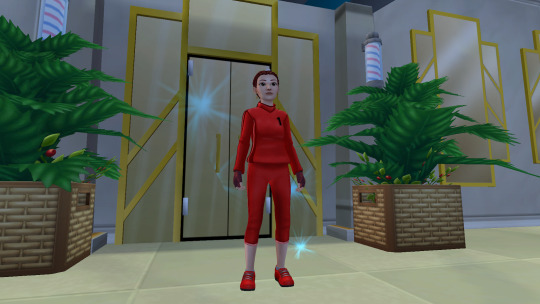
I am very normal about the horse game.
From the barracks to the pier, it takes 38 seconds to cross the map. On a similarly flat surface on Jorvik, we can measure how long Pier 13 actually is, giving us this comparison.
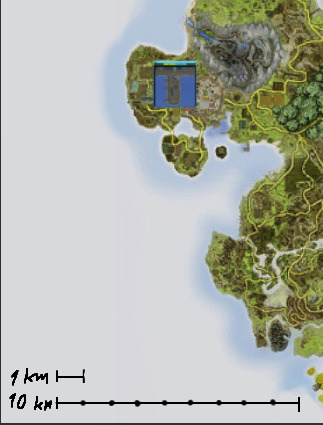
Now, I’m going to show two theories on how big Jorvik City is based on these measurements.
The first one is the most canon-compliant, but also the most ridiculous. By comparing pier 13 to the area outside jorvik stables, we know that pier 13 is ~1 km long. Yes, this is an absolutely massive pier don’t worry about it. Looking at the jorvik city map, we can see that this smaller pier is meant to be to represent Pier 13, and we can do the math from there. Jorvik gets an area of 340 square km, and if we use Stockholms population density as a guide, Jorvik City has about 1,8 million citizens. Cool! One problem though.

You can’t fit it on the map. A city this big would take up almost one fourth of Jorvik, and you’d need to redraw the entire map to make it fit.
So my other option shifts the canon a bit to make the maps fit together. If we go against canon and assume that Pier 13 is actually the larger pier, that downsizes Jorvik City to ~47,5 square kilometres, with a population of around 250 000. This makes Jorvik more comparable to a more densely populated Reykjavik; smaller in area but with double the amount of people. And while it still messes with the coastline a bit, it at least fits into Central Bay.

Personally I think both theories work, but for consistency’s sake, I’m leaning more towards the second theory.
276 notes
·
View notes